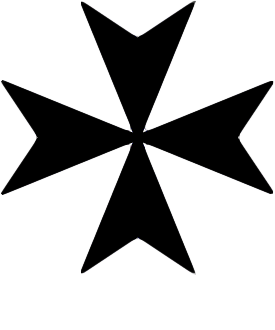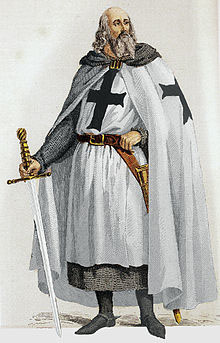 The United Religious, Military and Masonic Orders of the Temple and of St John of Jerusalem, Palestine, Rhodes and Malta in England and Wales and Provinces Overseas
The United Religious, Military and Masonic Orders of the Temple and of St John of Jerusalem, Palestine, Rhodes and Malta in England and Wales and Provinces OverseasProvince of Kent


Origins of the Knights of Malta - A Personal Exploration by E Kt Martin Hampton
 I believe that, as Knights Templar we are mostly fairly well acquainted with the origins of the original order, and the key original knights, right the way through to the excommunication on Friday 13th October 1307 and the eventual suppression of the Order in 1312, with the final Grand Master Jacques de Molay being burnt at the stake in Paris on the evening of March 18, 1314.
I believe that, as Knights Templar we are mostly fairly well acquainted with the origins of the original order, and the key original knights, right the way through to the excommunication on Friday 13th October 1307 and the eventual suppression of the Order in 1312, with the final Grand Master Jacques de Molay being burnt at the stake in Paris on the evening of March 18, 1314.But as Knights of Malta what do we know of the origins of this Military Order. If we remember we have a brief explanation of the Banners when we first become Knights of Malta but then nothing further, yet it is this order that survives to this day.
The following is my brief interpretation of the origins of the Knights of St John of Jerusalem or the Hospitaller Knights, also known as the Knights of Malta, which I am sure, will open avenues to further investigations into this illustrious Order. So let's begin our journey.
In about 1070 a group of Merchants from the port of Amalfi in Italy, established the Hospice of St John the Almoner close to the Church of the Holy Sepulchre. A hospice, at that time, being essentially a place where Pilgrims to the Holy Land might find rest and obtain food to recover from their long travels. This Hospice was believed to be run by Benedictine Monks and Nuns from Amalfi under the supervision of one Brother Gerard.
Either before or during the siege of first Crusade, this Hospice had been closed by the Moslem defenders and the staff expelled from the city; but after the siege Bro. Gerard and presumably the Monks and nuns, reappeared, and the crusaders willingly supported him when he set up a hospital to care for the sick. The first rulers of Jerusalem recognised the valuable work, by making gifts of land and booty to the Monks, so that by 1120, when Gerard died the hospital had managed to establish a chain of hospices throughout the Holy Land.
In 1113 Gerard had abandoned the Benedictine rule for that of St. Augustine, and the Hospitallers had been created an independent religious order by papal bull. Gerard's successor Raymond du Puy, extended the original work of the new Order until all the main ports of embarkation for pilgrims were equipped with a hospital operated by the order of St John. However he also extended the role of the order to the protection of pilgrims on the route from the Sea to Jerusalem. The Order's charter included the instruction that it could take up arms in the defence of it's hospitals, the Order itself or Jerusalem; but this logical extension of the orders duties towards pilgrims was to cause a major change in the structure of the order itself.
In 1126 a Constable of the Order is mentioned, suggesting that there was now some permanent military commitment possibly involving hired troops, although no details are known. However, there is mention in other documents of 20 monks being detailed to guard the tomb of Christ, and these became known as the Canons of the Sepulchre ('canon' being an ecclesiastical term originally applicable to all the clergy of any church). Apparently crusaders also swore obedience to the Prior of this body, and took upon themselves the military duties of guarding the tomb, The military members are said to have white mantles bearing the red cross of Jerusalem possibly a white surcoat with a single red cross on it and to have carried into battle a white banner speckled with red drops to signify the Holy Blood. These were presumably not members of the Order but were the first knights to volunteer to fight for Order. The later, true Knights of St John were sometimes referred to as the Knights of the Holy Sepulchre, and when King Alfonso of Aragon and Navarre died in 1134 he left his kingdom to the Hospitallers, the Templars and the Canons of the Holy Sepulchre.
In 1130 the Pope ordained that "the Religious war against the Infidel shall bear the standard, with the white cross in a field of red". Six years later the Order was given the key fortress of Gibelin by the King of Jerusalem in 1139 Count Raymond II of Tripoli, a confrere of the Hospitallers, bestowed on the Order two of his main castles: and in 1142 the Order received four other castles, including the great Krak des Chevaliers. Such possessions demanded troops to garrison them (the Krak des Chevaliers alone required a garrison of 200 knights and sergeants to withstand a siege), but there are no records of the Order being involved in any military role at this period. Yet it is inconceivable that the rulers in the Holy Land would have handed such important fortresses to an organisation incapable of defending them. We know that in 1157 the Order sent a column to relieve the castle of Banyas, and in 1168 it contributed 500 knights in the expedition to Egypt. It has to be assumed that sizeable military forces were available to by at least 1136. By this date there existed the office of Marshal, whose role was initially the hiring and control of mercenaries to perform the military duties of the Order, but there is no record of who commanded the Order's own contingent of 500 knights in 1168. Nured-Din, Atabeg of Mosul, in 1157, considered the Order's soldiers sufficiently formidable to order the execution of those captured, however it is unclear whether these were members of the Order, knights holding fiefs with the military duties owed to the order, or possibly mercenaries.

In 1179 a Papal Bull was issued instructing the Order not to depart from its original objectives and not until after the disastrous battle of Hattin in 1187, that the Pope recognised the need for their military role. Even so, he still did nothing to encourage it, and it was not until 1206 that the Order's statutes were revised to provide for military brethren, by which date all the important offices of offices of the Order were in the hands of the soldier-brethren and the Marshal was second in importance only to the Grand Master.
By this date membership of the Order could take several forms. There were brother priests and sisters of St John who fulfilled the Hospitaller duties, and brother Knights and sergeants for the military role. However, the only recognised division up to 1206 was between priests and lay brethren. Confrere knights were admitted under the same system as described for the Templars. In Europe the houses or 'commanderies' were ruled by commanders, and were grouped into provinces called 'priories', ruled by priors. By the late 12th century the priories had been collected into larger units called 'grand commanderies', and by the late 13th century these had been grouped into seven 'Langues', or 'tongues'. The hierarchy of the Order resided in the Holy Land and consisted of the Grand Commander of the Order, the Marshal, the Hospitaller, the Treasurer, the Drapier (quartermaster), and the Turcopolier.
Every knight was allowed to own four horses, and he was probably also permitted two squires, one to lead the spare horses, the other to carry his lance. Both squires were non-combatant and retired to the rear when action was imminent, where they came under the authority of the Gonfanonier. Sergeants were permitted two horses, and in 1302 they were allowed a squire. The rank of Military Esquire, presumably commanding the squires, was an important military office by this date, suggesting that at least some of the squires may now have had an active military role. The sergeants seem to have been fewer in number than the knights, and used less expensive armour.
By the early 13th century the Hospitallers rivalled the Templars as a military power, with perhaps 600 brethren at arms, and clashes between the two Orders became more and more frequent. In 1216 Antioch was captured by the Hospitallers from the Templars, but the city rose in revolt, expelled the Hospitallers and confiscated all of the Order's possessions in that state. By 1240 the diplomatic and political manoeuvres of the two Orders were aimed less against the Infidel than against each other. The situation became so bad, with Templars and Hospitallers killing each other in the streets of Acre, that in 1258 a treaty was drawn up to govern the settlement of quarrels between them. But it was already too late.
The decline had begun with the loss of Jerusalem in 1243, and gained speed as the century drew to an end. At Gaza in 1244 in excess 300 Hospitaller knights and their Master were captured. Over the next 25 years the desperate resistances of isolated garrisons failed to prevent stronghold after stronghold from falling to the Moslems. By 1271 the greatest fortress in the whole of Christendom, the Krak des Chevaliers, had fallen - forced to surrender for lack of sufficient men to defend it. Tripoli fell in 1289; and two years later it was the turn of Acre, called St Jean d'Acre after the magnificent Hospitaller church there. After eight weeks of heroic resistance Acre fell, and the Hospitallers died to a man, fighting alongside their former enemies, the Templars.
Within a year of the fall of Acre they had established new headquarters on their lands in Cyprus, with a castle at Colos and the headquarters at Limassol. The Order had a fleet since the early 13th century, and operations against the infidels were continued in a small way by raids on the mainland. These raids consisted of a landing, the burning of a village or two, and then a swift withdrawal.
The King of Cyprus, remembering the great power of the Orders in the Holy Land due to gifts of land there, refused to grant the Hospitallers land in his kingdom. Unable to grow or rebuild to its former military power, the Order began to look elsewhere for its future. Unlike the Templars who had resorted to banking, the Hospitallers seem to have realised from their first puny seaborne raids against the Moslems that a military alternative still existed. To survive they must change, and being now an island-based power, they would change from a land power to a naval one. The office of Admiral first appears in 1301. in reference to a small fleet raised the previous year. But these would have been mainly transports used for bringing troops, pilgrims and stores to and from the Holy Land. Such vessels would still be required, as would fighting ships, galleys and galleasses, it is while the Order was on Cyprus that such ships are first mentioned.
Seeking expansion, and seizing on the encroachment of some Moslems on the Byzantine owned island of Rhodes as an excuse, the Order obtained permission from the Pope to expel the Infidel intruders. The first major naval operation from Cyprus was therefore against Rhodes, in 1306. By end of 1307 the Hospitallers had taken an important stronghold, the fortress of Mount Phileremos; astride the main ridge of mountains and less than ten miles south of the city of Rhodes, Pope Clement V issued a confirmation of the Order's possession of the island in August that year that read: "that island which you have taken under your powerful arm, and which today by God's grace you, having driven thence the schismatics [the original Christian owners] and completely over-thrown the Infidel."
In fact the city of Rhodes was to hold out for her two years, teaching the Hospitallers the great value of the city as a defensible headquarters costing them their revenues for the next 20 years, against which they obtained a loan from a Venetian money-lender.
This discovery of a new military role from their offshore headquarters, and their 'crusade' against the Infidels on Rhodes, ensured that when the general reaction set in against the military orders after the loss of the Holy Land, the future of the Hospitallers was not seriously threatened. Instead, the possessions of the suppressed Templars passed into their hands. Even this enormous revenue did not clear their debt, however, for they had undertaken a vast programme of building, constructing massive fortifications on Rhodes as well as building a fleet of warships and colonising several of the islands of the Dodecanese. By 1320 the Hospital owed 500,000 florins to two Italian banking houses. These debts were eventually paid off and a credit established; but in 1343 and 1346 the two banking houses went bankrupt, wiping out the Hospitallers' credit of some 360,000 florins.
The history of the Order and it's connections with Malta, is very well documented after this era of existence so I will end this paper here, but would just say again as I said at the beginning of the paper the Order of St John is still in very heavily involved in it's original goals - such as the St Johns Ambulance Services in The United Kingdom as well as over 40 other countries around the world, In Jerusalem the original Ophalmic Hospital still stands, and was built on the Bethlehem road not far from the Jaffa Gate within sight of the ruined 12th Century Hospitaller church at Acheldamach. The Sovereign Military Hospitaller Order of Saint John of Jerusalem, of Rhodes, and of Malta, the Order operated from Rhodes (1310-1523), and later from Malta (1530-1798), over which it was sovereign.
Although this sovereign state came to an end with the ejection of the Order from Malta by Napoleon, the Order as such survived. It retains its claims of sovereignty under international law and has been granted permanent observer status at the United Nations. Thank you for your indulgence on this subject, I hope that you have all found this of interest.
Em Kt M Hampton
< return to main Knights of Malta page